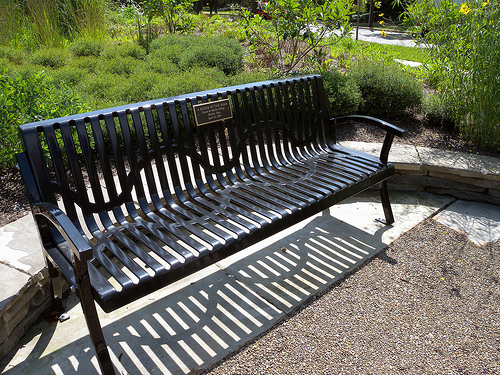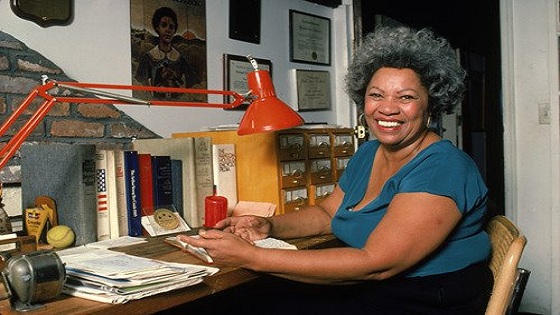Thinking about gaps in our communal memory has long occupied Nobel Laureate Toni Morrison. In a 1989 interview, she said:
“There is no place you or I can go, to think about or not think about, to summon the presences of, or recollect the absences of slaves . . . There is no suitable memorial, or plaque, or wreath, or wall, or park, or skyscraper lobby. There’s no 300-foot tower, there’s no small bench by the road. There is not even a tree scored, an initial that I can visit or you can visit in Charleston or Savannah or New York or Providence or better still on the banks of the Mississippi. And because such a place doesn’t exist . . . the book had to.”
The book is her novel Beloved, now firmly in the American canon and winner of a 1988 Anisfield-Wolf Book Award. Morrison’s remarks galvanized a clutch of scholars, who organized the “Bench by the Road Project” in 2006 on the novelist’s 75th birthday. The Toni Morrison Society installed the first bench two years later on South Carolina’s Sullivan’s Island, gateway of 40 percent of the Africans who came to North America.

Professor Marilyn S. Mobley witnessed that quiet, first monument set upright on the island at the entrance to Charleston Harbor. She attended the second bench placement near Oberlin College, saw another installed in Paris, France and yet another on the campus of George Washington University in Washington, D.C. Each spot is a link to the African-American resistance history that Morrison evokes.
The 19th bench, dedicated this April in Cleveland, sits on a green swell of lawn in University Circle, identical in its simple design to the benches installed before it: black ribbed steel, a length of four or six feet, with a descriptive plaque mounted in a cement foundation next to it. On a recent spring morning, sparrows and squirrels hopped and scurried around it.
Mobley, vice president of inclusion, diversity and equal opportunity at Case Western Reserve University, said she spent two years working toward putting a bench in the neighborhood adjacent to campus, a community once active on the Underground Railroad.
“It was worth my time and trouble because I believe in the concept of the need to remember — remember and celebrate,” she said. “I want to remember this history, which is part of our identity as Americans: there was a group of people who made this difficult journey to freedom. We were more than our suffering, our indignity.”
Mobley collaborated with Joan Southgate, the legendary retired social worker, who, at the age of 73 in 2002, began walking from Ripley, OH to St. Catharines, Ontario, the terminus of Harriet Tubman’s Underground Railroad. She completed the 519 miles and walked 250 more back to Cleveland.
“To tell you the truth, I didn’t know much about the Bench by the Road until Marilyn brought the idea to me,” Southgate said. “It couldn’t have been more perfect. It’s what my walk was all about.”
Southgate expressed her deep pleasure with the placement of the bench on the lawn of the Cozad-Bates House, 11508 Mayfield Rd. It is the only pre-Civil War building left standing in this Cleveland neighborhood. Southgate is working to see that the structure, owned by University Circle Inc., will eventually reopen as a small abolitionist museum combined with a guesthouse for transplant patients.
“This bench is placed in recognition of the heroic freedom seekers who made the arduous journey to freedom along the Underground Railroad, aided in part by Cleveland’s African-American and White anti-slavery community,” reads the permanent proclamation. “Horatio Cyrus Ford and Samuel Cozad III, successful businessmen and property owners in the area now known as University Circle and African-American businessman and civil rights activist, John Malvin, were exemplars of Cleveland’s participation in the resistance to slavery and in the struggle for social justice. This bench is a memorial to the freedom seekers who passed through Cleveland and to those Cleveland residents who assisted them on their journey.”
The Toni Morrison Society states that “the goal of the Bench by the Road Project is to create an outdoor museum that will mark important locations in African American history both in the United States and abroad.” Its president, Carolyn Denard, flew from Atlanta to Cleveland to see the 19th bench unveiled.
Raymond Bobgan, executive director of Cleveland Public Theatre, said he would not have joined in the bench project without the blessing of Southgate. “We need to continue to acknowledge what we aren’t proud of in our history,” he said. “People sometimes say, ‘My family didn’t own slaves’ but the same people are happy to claim, say, the founding fathers. Well, both are our history, and both have repercussions in our lives.”
The 20th bench will be installed July 26 in Harlem, New York at the Schomburg Library in recognition of the institution’s century-long commitment to preserving, archiving and telling African-Americans stories. Papers from many winners of the Anisfield-Wolf Book Awards can be found on its premises, and embedded in the terrazzo tile of the lobby is a design honoring Langston Hughes’ seminal poem “The Negro Speaks of Rivers.”



